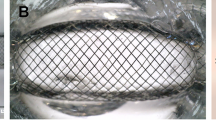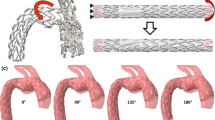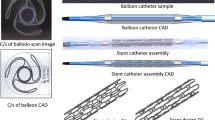Abstract
Purpose
An important issue in the deployment of braided stents, such as flow diverters, is the change in length, also known as foreshortening, underwent by the device when is released from the catheter into a blood vessel. The position of the distal end is controlled by the interventionist, but knowing a priori the position of the proximal end of the device is not trivial. In this work, we assess and validate a novel computer method to predict the length that a braided stent will adopt inside a silicon model of an anatomically accurate vessel.
Methods
Three-dimensional rotational angiography images of aneurysmatic patients were used to generate surface models of the vessels (3D meshes) and then create accurate silicon models from them. A braided stent was deployed into each silicon model to measure its length. The same stents deployed on the silicon models were virtually deployed on the 3D meshes using the method being evaluated.
Results
The method was applied to five stent placements on three different silicon models. The length adopted by the real braided device in the silicon models varies between 15 and 30 % from the stent length specified by the manufacturer. The final length predicted by the method was within the estimated error of the measured real stent length.
Conclusions
The method provides, in a few seconds, the length of a braided stent deployed inside a vessel, showing an accurate estimation of the final length for the cases studied. This technique could provide useful information for planning the intervention and improve endovascular treatment of intracranial aneurysms in the future.








Similar content being viewed by others
References
Appanaboyina S, Mut F, Löhner R, Putman CM, Cebral JR (2009) Simulation of intracranial aneurysm stenting: techniques and challenges. Comput Methods Appl Mech Eng 198(45):3567–3582
Bernardini A, Larrabide I, Morales HG, Pennati G, Petrini L, Cito S, Frangi AF (2011a) Influence of different computational approaches for stent deployment on cerebral aneurysm haemodynamics. Interface Focus 1(3):338–348
Bernardini A, Larrabide I, Petrini L, Pennati G, Flore E, Kim M, Frangi AF (2011b) Deployment of self-expandable stents in aneurysmatic cerebral vessels: comparison of different computational approaches for interventional planning. Comput Methods Biomech Biomed Eng 15(3):303–311
Chalouhi N, Satti S, Tjoumakaris S, Dumont A, Gonzalez L, Rosenwasser R, Jabbour P (2013a) Delayed migration of a pipeline embolization device. Neurosurgery 72(2 Suppl Operative):229–234
Chalouhi N, Tjoumakaris S, Gonzalez L, Hasan D, Pema P, Gould G, Rosenwasser R, Jabbour P (2013b) Spontaneous delayed migration/shortening of the pipeline embolization device: report of 5 cases. AJNR 34:2326–2330
De Beule M, Van Cauter S, Mortier P, Van Loo D, Van Impe R, Verdonck P, Verhegghe B (2009) Virtual optimization of self-expandable braided wire stents. Med Eng Phys 31(4):448–453
Golitz P, Struffert T, Rosch J, Ganslandt O, Knossalla F, Doerfler A (2015) Cerebral aneurysm treatment using flow-diverting stents: in-vivo visualization of flow alterations by parametric colour coding to predict aneurysmal occlusion: preliminary results. Eur radiol 25(2):428–435
Hauck E, Natarajan S, Langer D, Hopkins L, Siddiqui A, Levy EI (2010) Retrograde trans-posterior communicating artery snare-assisted rescue of lost access to a foreshortened pipeline embolization device: complication management. Neurosurgery 67(2 Suppl Operative):495–502
Jedwab MR, Clerc CO (1993) A study of the geometrical and mechanical properties of a self-expanding metallic stent-theory and experiment. J Appl Biomater 4(1):77–85
Larrabide I (2014) Procedimiento para la determinación de la longitud final de stents antes de su colocación. Oficina Española de Patentes y Marcas (ES2459244 A1):P201331,605
Larrabide I, Kim M, Augsburger L, Villa-Uriol MC, Rüfenacht DA, Frangi AF (2012) Fast virtual deployment of self-expandable stents: method and in vitro evaluation for intracranial aneurysmal stenting. Med Image Anal 16(3):721–730
Levitt MR, McGah PM, Aliseda A, Mourad P, Nerva J, Vaidya SS, Morton R, Ghodke B, Kim LJ (2014) Cerebral aneurysms treated with flow-diverting stents: computational models with intravascular blood flow measurements. Am J Neuroradiol 35(1):143–148
Lorensen WE, Cline HE, Company GE (1987) Marching cubes: a high resolution 3D surface construction algorithm. Comput Graph (ACM) 21(4):163–169
Lubicz B, Collignon L, Raphaeli G, Pruvo JP, Bruneau M, De Witte O, Leclerc X (2010) Flow-diverter stent for the endovascular treatment of intracranial aneurysms: a prospective study in 29 patients with 34 aneurysms. Stroke 41(10):2247–2253
Ma D, Dargush GF, Natarajan SK, Levy EI, Siddiqui AH, Meng H (2012) Computer modeling of deployment and mechanical expansion of neurovascular flow diverter in patient-specific intracranial aneurysms. J Biomech 45:1–8
Material Property Data (1990) http://www.matweb.com. Accessed 9 Feb 2015
Mut F, Cebral JR (2012) Effects of flow-diverting device oversizing on hemodynamics alteration in cerebral aneurysms. Am J Neuroradiol 33(10):2010–2016
Nelson PK, Lylyk P, Szikora I, Wetzel SG, Wanke I, Fiorella D (2011) The pipeline embolization device for the intracranial treatment of aneurysms trial. Am J Neuroradiol 32(1):34–40
Peach TW, Ngoepe M, Spranger K, Ventikos Y (2014) Personalizing flow-diverter intervention for cerebral aneurysms: from computational hemodynamics to biochemical modeling. Int J Numer Meth Biomed Eng 30:1387–1407
Piccinelli M, Veneziani A, Steinman DA, Remuzzi A, Antiga L (2009) A framework for geometric analysis of vascular structures: application to cerebral aneurysms. IEEE Trans Med Imaging 28(8):1141–1155
Rouchaud A, Leclerc O, Benayoun Y, Saleme S, Camilleri Y, D’Argento F, Boncoeur MP, Robert PY, Mounayer C (2015) Visual outcomes with flow-diverter stents covering the ophthalmic artery for treatment of internal carotid artery aneurysms. AJNR Am J Neuroradiol 36(2):330–336
Sadasivan C, Cesar L, Seong J, Rakian A, Hao Q, Tio FO, Wakhloo AK, Lieber BB (2009) An original flow diversion device for the treatment of intracranial aneurysms: evaluation in the rabbit elastase-induced model. Stroke 40(3):952–958
The Vascular Modelling Toolkit (VMTK) (2000) http://www.vmtk.com. Accessed 9 Feb 2015
Wong GKC, Lau JCY, Poon WS (2011) Flow diverters for treatment of intracranial aneurysms: current status and ongoing clinical trials. J Clin Neurosci 18(6):737–740
Conflict of interest
H. Fernandez, L. Serra and I. Larrabide are stockholders in Galgo Medical S.L.; W. Mailaender is employed by Acandis GmbH.
Author information
Authors and Affiliations
Corresponding author
Rights and permissions
About this article
Cite this article
Fernandez, H., Macho, J.M., Blasco, J. et al. Computation of the change in length of a braided device when deployed in realistic vessel models. Int J CARS 10, 1659–1665 (2015). https://doi.org/10.1007/s11548-015-1230-1
Received:
Accepted:
Published:
Issue Date:
DOI: https://doi.org/10.1007/s11548-015-1230-1




